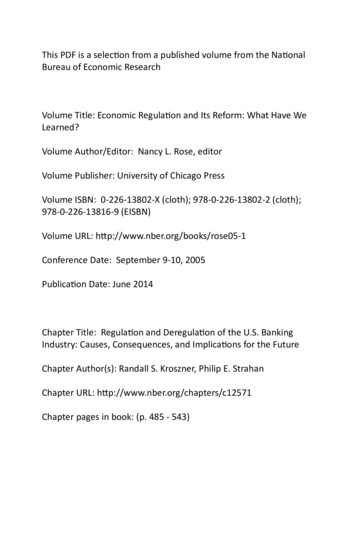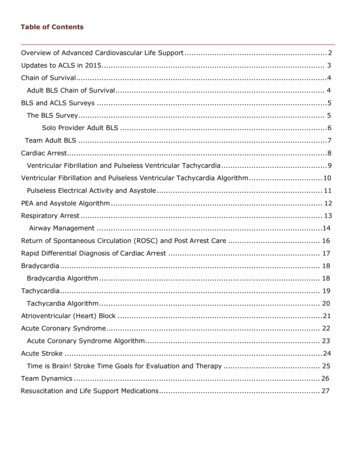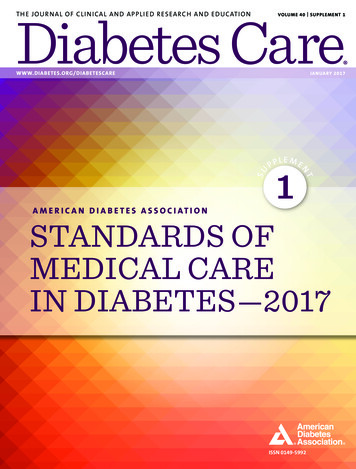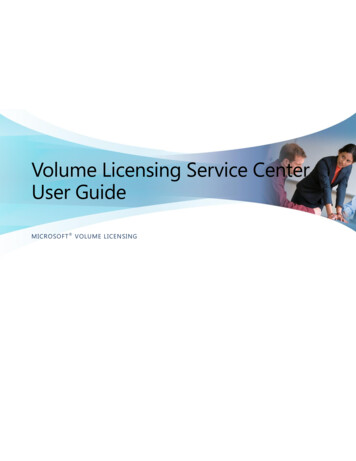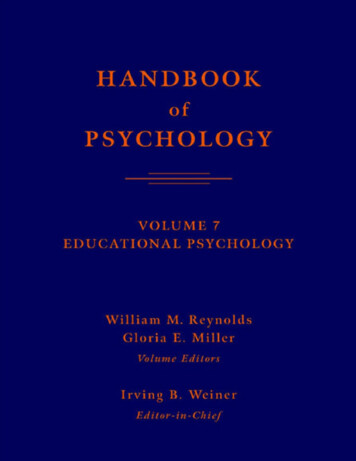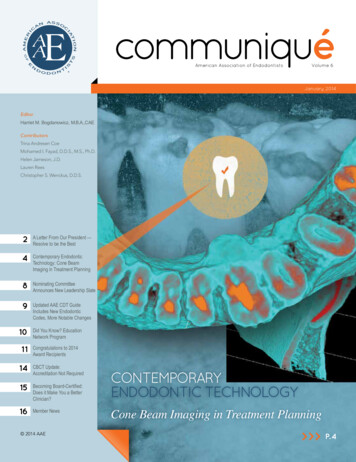
Transcription
American Association of EndodontistsVolume 6January 2014EditorHarriet M. Bogdanowicz, M.B.A.,CAEContributorsTrina Andresen CoeMohamed I. Fayad, D.D.S., M.S., Ph.D.Helen Jameson, J.D.Lauren ReesChristopher S. Wenckus, D.D.S.2A Letter From Our President —Resolve to be the Best4Contemporary EndodonticTechnology: Cone BeamImaging in Treatment Planning8Nominating CommitteeAnnounces New Leadership Slate9Updated AAE CDT GuideIncludes New EndodonticCodes, More Notable Changes1011Did You Know? EducationNetwork ProgramCongratulations to 2014Award Recipients14CBCT Update:Accreditation Not Required15Becoming Board-Certified:Does it Make You a BetterClinician?16Member News 2014 AAECONTEMPORARYENDODONTIC TECHNOLOGYCone Beam Imaging in Treatment Planning P. 4communiqué / january 2014 /1
PRESIDENT’S MESSAGECommuniqué Editorial Boardresolve to be the BestMEMBERSHIP SERVICES COMMITTEEDerrick I. Wang, ChairDerik P. DeConinckCarla Y. FalconKenneth J. FrickMaria C. MarangaColleen C. ShullMartha P. ZindermanCraig C. DeagleStefan I. Zweig, Board LiaisonEach New Year, many of us makeresolutions. Some are aimed at takingcare of ourselves – losing weight,eating better, exercising more.COMMUNICATIONS COORDINATORLauren ReesExEcutivE committEEGary R. HartwellPRESIDENTRobert S. RodaPRESIDENT-ELECTTerryl A. PropperVICE PRESIDENTGarry L. MyersSECRETARYLinda G. LevinSome are for the greater good – maybe you hope to volunteermore time to a worthy charity. And some may be more personalin nature – striving to be a better person, spouse or parent.Gary r. Hartwell, d.d.s., m.s. Regardless of our intention, we are all striving to be the best atAAE Presidentwho we are and what we do.This is one of the many reasons that a majority of us devote time to our professionalorganization – to be the best clinician and to keep the work that we do cutting-edge, evidencebased and at the forefront of dentistry. In order to accomplish these goals, most of us dependTREASURERJames C. KulildIMMEDIATE PAST PRESIDENT Board of dirEctorsJOE EditorKenneth M. HargreavesAAE Foundation PresidentKeith V. KrellDistrict ITevyah J. DinesPaula RussoDistrict IIRichard L. RubinCraig S. HirschbergDistrict IIIArthur L. ColeMarc E. LevitanDistrict IVGerald C. Dietz, Jr.Anita AminoshariaeDistrict VGary G. GoodellJames F. WolcottDistrict VIBruce C. JustmanMichael G. StevensDistrict VIIAlan H. GluskinStefan I. ZweigCommuniqué is published by theAmerican Association of Endodontists211 E. Chicago Ave., Suite 1100,Chicago, IL 60611Phone: 800/872-3636 (U.S., Canada, Mexico)or 312/266-7255866/451-9020 (U.S., Canada, Mexico)or 312/266-9867Web: @SavingYourTeethimportant dates and deadlinesvisit www.aae.org/events for more information.february 7AAE Foundation ResearchGrant Spring Deadlinewww.aae.org/foundationmarch 1Annual Session EducatorGrant Deadlinewww.aae.org/foundationmarch 26Annual Session EarlyRegistration Deadlinewww.aae.org/annualsessionWith this issueThis issue of the Communiqué ushers in a select series of articles exploring contemporaryendodontic technology. Dr. Mohamed I. Fayad’s cover story (Contemporary EndodonticTechnology: Cone Beam Imaging in Treatment Planning, pp. 4-7 in this issue) presents clinicalapplications of cone beam technology in the endodontic practice that may be helpful to specialistsconsidering the advantages of this diagnostic tool. The February and March cover stories of thee-Communiqué will examine primary considerations in evaluating practice management software.Other editorial themes planned for the coming year include endodontic advocacy (2ndquarter), trends in dental collaboration (3rd quarter) and practice management (4th quarter).Authors and article topics are identified by endodontist volunteers on the MembershipServices Committee in response to AAE member needs. Feedback from AAE membersis always welcome, and may be published in a new “Letters to the Editor” section of theCommuniqué web pages at www.aae.org/communique. Please submit comments via email tocommunications@aae.org to ensure the continued evolution of our member newsletter!
on our peers, collaborating with those inour inner circle. But to truly be successful –the best that we can be – I strongly believethat we must also join forces with our colleagues in other specialties.The AAE fosters such cooperationby engaging with other organizations inmany ways including developing jointstatements, collaborating on research andthrough continuing education offerings.In recent years the AAE has had very successful collaborative symposia coveringthe topics of pediatric dentistry and theimmature permanent dentition as wellas trauma. One effort that I am proud tohighlight is an upcoming joint symposium — a partnership of the AmericanAssociation of Endodontists, AmericanAcademy of Periodontology and theAmerican College of Prosthodontists onsaving the natural dentition.Teeth for a Lifetime: InterdisciplinaryEvidence for Clinical Success has beenplanned with the clinician in mind. Nationaland international experts from all threespecialties will share contemporary evidence and best practices for saving thenatural dentition through lectures andpanel discussions that are compelling toa multidisciplinary audience. Endodonticexperts will include Drs. Alan H. Gluskin,Alan S. Law, Ove A. Peters and JamesL. Gutmann. Citing both literature andclinical examples from each discipline,the program will focus on diagnostic andassessment methods used in determiningthe structural and periodontal prognosisof teeth; 3-D dental imaging; regenerative, surgical and restorative therapeutics;indications and treatment proceduresrequired for success in periodontal diseaseand teeth with immature root formation,interdisciplinary communication and teamapproaches. In addition to a forwardlooking educational offering there will alsobe time to foster collegiality and informal2014discussion amongst participants.I hope you will join me July 19 -20 inChicago in an effort to gain new perspectives and skills to apply in your specialtypractice with colleagues from across therestorative disciplines – or more simply, tobe the best that we can be.A happy, healthy and successful New Yearto all! Visit www.aae.org/teethforalifetimeto learn more and view thepreliminary schedule for the2014 Joint Symposium.communiqué / january 2014 /3
FEATUREContemporary Endodontic Technology:Cone Beam Imaging in Treatment PlanningIn endodontology, clinical examination and diagnostic imaging are both essential componentsof the preoperative diagnosis. Accurate diagnostic imaging supports the clinical diagnosis andallows the clinician to better visualize the area in question.By Mohamed I. Fayad, D.D.S., M.S., Ph.D.Conventional two-dimensional radiographs continue to be themost popular method of imaging today. However, the diagnosticpotential of periapical radiographs is limited. Information maybe difficult to interpret, especially when the anatomy and background pattern is complex.New radiographic imaging systems have recently becomeavailable for use in dentistry. Among these new imaging technologies is cone beam volumetric tomography, or CBVT. In 2000, theU.S Food and Drug Administration approved the first CBVT unit fordental use in the United States. CBVT systems are available in different field of views (FOV): CBVT limited (dental) ranges in diameterfrom 40 –100 mm or full (ortho or facial) CBVT ranges from 100 –200mm. The voxel size is generally smaller for the limited version (0.1–0.2 mm vs. 0.3– 0.4 mm), thus offering higher resolution and greaterutility for endodontic applications. For endodontic applications,the limited field of view is the most acceptable, as it is capable ofproviding images at a low radiation dose and with sufficient spatialresolution for endodontic diagnosis and treatment planning.While there are presently no definitive patient selectioncriteria for the use of CBVT in endodontics, the use of CBVT inendodontic diagnosis and treatment should not be avoided orignored.Preoperative Anatomy AssessmentTooth Morphology: The success of endodontic treatment depends on the identification of all root canal systems so that they can betreated. The efficacy of CBVT as a modality to accurately explore tooth anatomy and identify the prevalence of a second mesiobuccalcanal (MB2) in maxillary molars when compared to the gold standard (clinical and histologic sectioning) has been well documented. Thecase “Tooth Morphology” is an example of using the 3-D rendering in determining the presence and location of missed lingual canals inlower anterior teeth prior to retreatment.Tooth MorphologyPreoperative X-ray4/www.aae.org/communiqueAxial 3-DSagittal 3-D rendering
Dental Periapical Pathosis: The most common pathologic conditions that involve teeth are inflammatory lesions of the pulp and periapicalareas. In articles comparing the accuracy of using high-resolution limited CBVT to the standard intraoral radiographic paralleling techniqueusing two images, CBVT identified an additional 62% of roots with periapical lesions and demonstrated higher accuracy. The case “DentalPeriapical Pathosis” is an example of a different representation of endodontic pathology based on 3-D imaging and leading to a change intreatment planning.Dental Periapical PathosisPreoperative X-rayCoronal viewAxial viewSagittal view3-D renderingRoot Fracture: Root fractures are less common than fractures of the crown and are difficult to diagnose accurately using conventional radiography. Numerous authors have illustrated the usefulness and importance of CBVT in the diagnosis and management of dentoalveolar trauma, especially root fractures. The case “Root Fractures” is an example of a distal root fracturethat was not visible or detected on a digital radiograph.Root FracturesSagittal viewPreoperative X-rayCoronal viewAxial view3-D renderingcommuniqué / january 2014 /5
Root Resorption: Several authors have presented selected cases illustrating the benefit of CBVT in the detection of smallresorptive lesions; localization and differentiation of the resorption from other conditions; classification of the lesion; and indetermining prognosis directing treatment.The accuracy of CBVT in the detection of surface defects is higher than conventional imaging modalities. The two cases below are two different representations of distal root resorption and invasive rootresorption that were not detected on the digital radiograph.Distal Root ResorptionPreoperative X-raySagittal view3-D renderingInvasive Root ResorptionPreoperative X-raySagittal viewCoronal viewAxial viewEndodontic Surgery Pretreatment: Molar surgeries are often complicated due to the proximity of teeth to anatomical structures(mandibular canal or maxillary sinus). CBVT imaging provides several advantages for preoperative treatment planning, especially inmaxillary posterior teeth with apical pathology. The case “Endodontic Surgery Pretreatment” is a representation of the 3-D extent ofthe periapical pathology. Two-dimensional imaging reveals the lesion to be localized to tooth #9, as the CBVT views reveal teeth #9,10 and 11 are involved with palatal bone destruction (through-and-through defect). CBVT information led to a change in treatmentplanning to include #9, 10, 11 and guided bone regeneration.Endodontic Surgery PretreatmentPreoperative X-ray6/www.aae.org/communiqueAxial viewCoronal view3-D rendering of palatal bone3-D rendering tracing the naso-palatine bundle
Postoperative AssessmentMonitoring the healing of apical lesions is an important aspect of postoperative assessment in endodontics. CBVT enables the clinician to assess healing in 3-D. The casebelow demonstrats a periapical infection breaking through the floor of the maxillarysinus. After root canal therapy, a CBVT one-year evaluation revealed complete boneregeneration as well as the reconstitution of the maxillary sinus floor. Resolution ofodontogenic maxillary sinus mucositis and regeneration of bone and sinus floor are welldocumented in the endodontic literature.additionalcone BeamimagingresourcesPreoperative CBVT scan of tooth #3One-year recall demonstration of the periapical lesionThe usefulness of CBVT imaging can no longer be disputed. CBVT has had a greatimpact and has changed dramatically how we diagnose, treatment plan and treat casesin endodontic practice. CBVT has great potential to become a valuable diagnostic andtreatment planning tool in the modern endodontic practice.Dr. Mohamed I. Fayad is a clinical assistant professor and director of endodonticresearch at the University of Illinois at Chicago College of Dentistry and is in privatepractice in Chicago. He can be reached at mfayad1@uic.edu.Online CEDr. Mohamed I. Fayad’s livepresentation, 3-D Imaging inEndodontics: A New Era in Diagnosisand Treatment, is now availablefor CE credit online via the LiveLearning Center to all subscribers.Visit www.aae.org/livelearningcenterfor access to all 2013 FallConference content or subscriptioninformation, as well as additionalpresentations on this topic from priorAAE meetings.Colleagues NewsletterThe Summer 2011 issue of theENDODONTICS: Colleaguesfor Excellence newsletter ConeBeam-Computed Tomographyin Endodontics authored byDr. Frederic Barnett providescomprehensive coverage of thistopic for dental professionals,and is available for free downloadwith online-only bonus contentat www.aae.org/colleagues.A companion speakers kit isavailable for purchase (PowerPointpresentation) for those interested insharing the content with study clubsand other professional groups fromthe AAE Online Store.Position StatementThe AAE has published a positionstatement on the Use of ConeBeam-Computed Tomography inEndodontics. The statement isavailable for free download atwww.aae.org/guidelines.communiqué / january 2014 /7
Nominating committee announcesNew leadership slateNominations for a new slate of leadership were proposed at the AAE Nominating Committee meetingon December 6, 2013. The committee members, Drs. Clara M. Spatafore, chair; James C. Kulild, AAEimmediate past president; and William T. Johnson, AAE past president, together with District DirectorsTevyah J. Dines and Stefan I. Zweig, met at AAE Headquarters in Chicago to recommend new leaders forthe AAE, AAE Foundation and American Board of Endodontics.Additional nominations may be made in writing byActive and Life members. Such nominations must beaccompanied by a petition that includes the printednames and signatures of 50 voting members, and mustbe received by AAE Secretary Garry L. Myers, care ofAAE Headquarters, no later than April 2, 2014.aaE Executive committee 2014-2015PresidentRobert S. Roda*President-ElectTerryl A. Propper*Vice PresidentLinda G. LevinSecretaryGarry L. MyersTreasurerPatrick E. TaylorImmediate Past President Gary R. Hartwell**Automatic, the president-elect automatically succeedsto president and the vice president to president-elect.aBE directors 2014-2017Stephen B. DavisCindy R. RauschenbergerAsgeir SigurdssonaaE foundation trustee 2014-2016Patricia A. TordikaaE foundation New Practitioner trustee 2014-2016Cameron M. HowardaaE foundation Public sector representatives 2014-2015Jack BurlisonScott FehrsTom KennedyThe following members were nominated by their respective districts to serve on the AAE Board of Directors for three-year terms(2014-2017):district iMichelle L. Mazur-Kary, Auburn, Mainedistrict iiMaria C. Maranga, Aquebogue, N.Y.district iiiMark A. Odom, Cary, N.C.district viKimberly A.D. Lindquist, Duluth, Minn.district viiNava Fathi, San Jose, Calif.Members will cast their votes at the 2014 General AssemblyBreakfast, which will be held on Friday, May 2, from 8:30 – 10 a.m.at the Gaylord National Resort and Convention Center in NationalHarbor, Md.8/www.aae.org/communique
updated aaE cdt Guide includes NewEndodontic codes, more Notable changesImportant updates, including new endodontic codes, are now available in the AAE’s free, downloadablee-book, Endodontists’ 2014 Guide to CDT, available at www.aae.org. Beginning January 1, 2014,dental practices must use CDT 2014 when filing claims. The existence of a code does not guaranteepayment, but claims that use the wrong codes will typically be automatically denied.Thanks to AAE advocacy efforts, CDT 2014 includes important changes in the Endodontic section (D3000-3999) to betterdescribe endodontic services. The CDT is now updated annually. Decisions to accept or reject proposed additions/deletions or amendments are made by the 21-member ADA CodeMaintenance Committee, which includes representatives fromthe ADA, each of the nine recognized dental specialties and theAcademy of General Dentistry, the payer (insurer) communityand the American Dental Education Association. The AAE’sPractice Affairs Committee is responsible for making recommendations on CDT revisions to the AAE Board.“The major changes to the CDT 2014 were under apicoecomy/periradicular surgery (D3410-D3470),” said Dr. KennethB. Wiltbank, AAE representative to the ADA committee.“Endodontists have been forced to use periodontic codes (e.g.D4367) when reporting bone grafting with endodontic surgery.Many insurers automatically deny these claims when they aresubmitted by non-periodontists, while other insurers requireadditional documentation, such as probing depth, which is not acomponent of endodontic treatment.”The CDT 2014 now includes four new endodontic codesthat cover all aspects of bone graft performed with endodonticsurgery. Those codes are D3428, D3427, D3431 and D3432. Dr.Wiltbank was quick to thank the other dental specialty groups,who supported these changes and worked together to craftlanguage that was acceptable to the entire CMC. CDT 2014 alsoincludes a new code for periradicular surgery without apicoectomy (D3427). This change provides a much more precise codedescription than using the apicoectomy codes (D3410, D3421,D3425, D3426).Another notable change is that pulpal regeneration is now itsown subcategory (D3355-D3357). When the pulpal regenerationcode first appeared in CDT 2011, it was lumped in with apexification/recalcification. Dr. Wiltbank observed that this change nicelyillustrates the negotiations that take place within the committee.“In 2010, we knew we had support for a code after a greatpresentation by Dr. Kenneth M. Hargreaves, but some CMCmembers were philosophically opposed to adding an entirelynew subcategory,” Dr. Wiltbank said. “So we compromised, andnow, three years later, after some patience, we can separate thecodes out.”AAE Practice Affairs Committee Chair Dr. William D. Powellsaid he is especially pleased with the progress the AAE hasmade in its advocacy for accurate endodontic codes.“In the past three cycles, we have obtained code changesthat we have been requesting for over a decade,” he said. “Wewant the CDT to reflect what endodontists actually do.” communiqué / january 2014 /9
DID YOU KNOW?Education Network ProgramInterested in endodontic education, but not sure where to start? The AAE’s Education Network Programoffers a way to assist educators and maintain excellence in endodontic education. The program consistsof more than 120 endodontists and endodontic alumni for each dental school and advanced specialtyeducation program in endodontics, who volunteer with the goal of assisting faculty with pertinenteducational issues and practical needs.You can join the Education Network Program to assist yourlocal school or alma mater by sharing your expertise andtime with predoctoral and postdoctoral students. Downloadthe volunteer sign-up form from the AAE website, or emaileducation@aae.org, and your name will be added to thenetwork. You’ll have the chance to choose your areas ofvolunteer interest, from supervising clinics to providing lectureson a variety of postdoctoral topics. Educators can search thevolunteer database online to find endodontists that can assistprogram directors and department chairs.Visit www.aae.org and go to the Educator Center formore on the Education Network Program and other educationresources, or contact Kara Brockman, education coordinator, atkbrockman@aae.org. aaE Begins search forExecutive directorMr. James M. Drinan, J.D. resigned his position asExecutive Director of the American Association ofEndodontists effective December 31, 2013. AAE PresidentDr. Gary R. Hartwell has appointed a special committeeto begin the search for a new Executive Director, and willserve as the AAE’s Interim Executive Director until thesearch process is completed.ErrataThe October 2013 Communiqué article titled “JOE Study Featured by The New York Times” incorrectly cited a statistic aboutpatients hospitalized for periapical abscesses. The article stated that 66 percent of those patients died. The correct statistic isas follows: Some 66 patients died after they were hospitalized for dental abscesses. The Communiqué regrets the error.10 /www.aae.org/communique
congratulations to 2014 award recipientsThe AAE proudly announces the most recent recipients of the organization’s highest honors and awards,to be recognized during the 2014 Annual Session in Washington, D.C. This year, the Edgar D. Coolidge,Louis I. Grossman, I.B. Bender Lifetime Educator, Edward M. Osetek, Spirit of Service Lifetime, Spirit ofService New Practitioner and Part-Time Educator Awards will be presented.Edgar D. Coolidge AwardLouis I. Grossman AwardA. Eddy Skidmore, D.D.S., M.S.José F. Siqueira, Jr., D.D.S., M.Sc., Ph.D.Given to an individual who hasdisplayed leadership and exemplarydedication to dentistry andendodontics.Given for cumulative publication ofsignificant research studies that havemade an extraordinary contribution toendodontology.“Ed is a superb individual. A contributor to the literature and ourknowledge of endodontics, he has also been a dedicated teacher, mentorand superb clinician. There is not much that Ed has not done for our field.Just recently, he served as president of the AAE Foundation and proceededto fundraise with such exuberance that he broke all records for the amountcollected in a year. When Ed does something for endodontics, he does as agentleman with the energy of 10 others.”– Louis E. Rossman, D.M.D.A. Eddy Skidmore, D.D.S.,M.S. has dedicated his professional life, and much of hispersonal time, to the dental andendodontic communities and tothe education of endodontists.Since 2004, Dr. Skidmore hasserved as an adjunct professorat Nova Southeastern University.He taught at the West VirginiaUniversity School of Dentistryfrom 1968 to 1993, resigningfrom the faculty as full professor, chairman and graduateprogram director in the department of endodontics. He was inprivate practice in Morgantown,W.V. from 1993 to 2004.In addition to being thepast president of the AAEFoundation from 2009 – 2012,Dr. Skidmore has served as president of the American Boardof Endodontics, past presidentof the College of Diplomatesand past president of his stateand local dental associations.He is a former delegate tothe ADA, and past chair ofthe endodontic section of theAmerican Association of DentalSchools. He also serves on theScientific Advisory Board for theJournal of Endodontics and isa former AAE District Directorand member of several AAEcommittees. He is an inspirationto his many students, bestowingupon them the value and importance of dental leadership, andhis fundraising efforts for theFoundation broke previousfundraising records. He continues to inspire new dentists andendodontists to continue thelegacy of leadership. “He has authored well over 250 scientific publications, many textbookchapters and a textbook on endodontic microbiology. His contributions inthat area of endodontics stand out among the so many talented researchersthat have contributed to our specialty. In addition to his own research andpublications, Dr. Siqueira has mentored many Ph.D. students that have alsocontributed to endodontics.”– Frederic Barnett, D.M.D.José F. Siqueira, Jr., D.D.S.,M.Sc., Ph.D., is an authoror co-author of 264 scientificpapers, seven books and 14book chapters. His researchon endodontic microbiologyand infection control iswidely cited, earning himthe Louis I. Grossman awardfrom the Societé Françaised Endodontie in 2012.Dr. Siqueira served as theassociate editor of the Journalof Endodontics from 2006to 2008, and is currently amember of the ScientificAdvisory Board for theJOE. He is on the editorialboard of the Journal of OralMicrobiology and ENDO –Endodontic Practice Today,and he serves as a reviewerfor several other internationaljournals.Dr. Siqueira’s ongoingresearch includes studieson the composition of theendodontic microbiotaassociated with differentforms of apical periodontitis,development and analysesof clinical strategies to dealwith endodontic infections,and the influence of diseasemodifiers on the patientresponse to treatment.He is actively lecturing onendodontics worldwide andcurrently serves as the chair ofendodontics and director ofthe postgraduate program inendodontics at Estácio de SáUniversity, in Rio de Janeiro,where he also mentors Ph.D.candidates. communiqué / january 2014 /11
I.B. Bender Lifetime Educator AwardEdward M. Osetek Educator AwardM. Lamar Hicks, D.D.S., M.S.Melissa M. Drum, D.D.S., M.S.Presented to an individual whohas been a full-time educatorfor at least 15 years, whosecontributions to endodontics havedemonstrated excellence throughselfless commitment to full-timeeducational pursuits and whosevaluable contributions have instilledin his/her students a desire to pursueexcellence in their careers.Presented to a full-time educator with lessthan 10 years of teaching experience, whohas earned the esteem and respect ofstudents and faculty associates.“Having come full circle in my educational association with Dr. Hicks –from student to co-educator – I have developed a profound appreciation forwhat it means to not only be a lifelong educator, but also a lifelong student.This is perhaps as great a lesson that he continually teaches as the initialinstruction. Truly, our learning never ends. Dr. Hicks recognizes this andattempts to instill this important concept in every person he mentors. In thisway, our profession moves forward and never stagnates.”“I strongly believe that Melissa is a rising young star who has alreadydeveloped a strong reputation at Ohio State and around the world via hercomprehensive series of endodontic randomized controlled trials. In manyways, she represents not only the finest of an excellent corps of endodonticeducators, but serves as a leader in developing new and effective ways toprepare the next generation of endodontists.”– Kenneth M. Hargreaves, D.D.S., Ph.D.– David M. Kenee, D.D.S., M.S.Since his first appointment in1975, M. Lamar Hicks, D.D.S.,M.S., has dedicated nearlyfour decades of his life toeducation. He got his start ineducation in Bethesda, Md.,on the staff of the endodonticsdepartment and as assistantdirector of the endodonticsresidency program at theNational Naval DentalCenter. He continued Navalendodontic education at theNaval Regional Dental Center,Naval Dental School andUniformed Services Universityof Health Sciences until heretired from the Navy in 1992.Despite his retirement, hecontinued to teach and mentor.In 1993, he became chair andprogram director of the I.B.Bender Division of Endodonticsat Albert Einstein MedicalCenter, and at the same timeserved as adjunct professor ofendodontics at the University ofPennsylvania School of DentalMedicine. He also continued toprovide support to the Naval12 /www.aae.org/communiquePostgraduate Dental School,helping with mock oral boardexams and other volunteerefforts. Most recently, he hasserved as a clinical professorat the University of MarylandDental School.In addition to thecountless students he hasmentored as an educator,Dr. Hicks is also a foundingmember of the College ofDiplomates, and has been anactive member of organizeddentistry while being involvedin local, state and nationalcomponents of the AAE andADA. Students and faculty alikeadmire his selfless and humblenature and willingness to helpany student. Melissa M. Drum, D.D.S.,M.S., received her Certificatein Endodontics from The OhioState University in 2006—thesame year she joined theschool as a tenure-trackfaculty member. Dr. Drumknew in dental school that shewanted to be an endodonticpredoctoral director, and she’sreached her goal, currentlyserving as associate professorand director of the predoctoralendodontic program atOSU. A “teacher of the newmillennium,” her peers notethat she is not only exceptionalat clinical and didacticeducation, but also at helpinginstill confidence in students.Dr. Drum is active inservice at the college, stateand national levels, and isalso engaged in research,currently contributing toanesthesia literature andactively developing her ownresearch focus of medicationsand methodologies tocontrol preoperative andpostoperative pain andanxiety. Dr. Drum becamea Diplomate in 2008 andreceived tenure in 2012.
Spirit of Service Lifetime AwardScott J. Hodges, D.D.S., M.S.Presented to an individual whohas demonstrated the true spiritof leadership over the years bycreating effective partnerships in thedental community, impacted dentalorganizations and benefited patientsby volunteering his or her time andexpertise in treating the underserved.“I have known Scott since we were endodontic residents together at theUniversity of Michigan School of Dentistry. He told me at that time weshould all feel blessed to have the opportunity to care for others. He felt thatit was a gift and that the most important thing to do with a gift is to share.He has devoted his life to helping those that without individuals like himwould have no help at all.”Spirit of Service New Practitioner AwardG. Matthew Brock, D.D.S., M.S.D.Presented to an individual with lessthan 10 years in practice who hasdemonstra
statements, collaborating on research and through continuing education offerings. In recent years the AAE has had very suc-cessful collaborative symposia covering the topics of pediatric dentistry and the immature permanent dentition as well as trauma. One effort that I am proud to highlight is an upcoming joint sympo-





